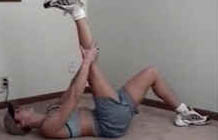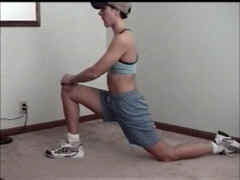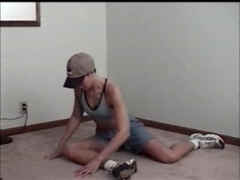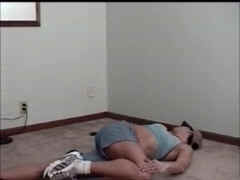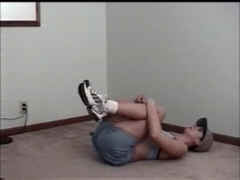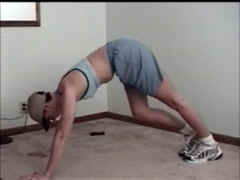Fancy a game of tennis? If you’re after a body of steel then your answer should be yes.
Tennis is a brilliant game and for a number of surprising reasons. For starters, it’s enormous fun. Secondly you can do it with friends and enjoy a bit of catch-up all at the same time and thirdly, it can help you build a rock-hard body, toned legs and firm arms.
That’s right, tennis may appear civilised, but in reality it’s anything but. As anyone who has played the game will tell you, tennis is a sweat-inducing, muscle burning, full-body workout. You only need to look at the incredible physiques of Venus Williams or Mark Philippoussis to see that.
“Tennis is a great workout,” says Mike Hetherington, a professional tennis teacher at Cooper Park Tennis Centre, Double Bay, in Sydney.
“It pretty much works your whole body. Tennis players have good legs and bottoms and their shoulders are great, too.”
If that hasn’t convinced you, then think about this. Your average game of tennis burns up roughly 500 kilojoules in 15 minutes. That equates to 1000kj in 30 minutes, 150kj in 45 minutes and close to a whopping 2000kj in just 60 minutes. Accordingly, just a couple of casual games a week and you’ll soon see the difference. Not only that, but your aerobic capacity will go through the roof, your hand-eye coordination will improve, as will your balance. So, who’s for a game?
playing by the rules
Traditionally tennis is played with two or four people. The idea is that you hit the ball over the net and between one another for as long as possible. If the game is played by the rules (and that’s entirely up to you) the ball should land within the white lines. If you’re playing doubles you only need worry about the white line behind you. If you’re playing singles, however, the ball cannot go past the white line behind you or into the sections on either side of the tennis court.
It sounds simple enough but when you’re just starting out (and actually even when you’re pretty good), it can be tricky to get the ball to go exactly where you’d like it to. The good news about that is that if the ball lands on the line it’s considered to be in. Excellent.
The main aim of tennis is to get more points and therefore win, but there’s much more to it than that. Like having a blast, for example.
“Tennis makes you fit which is great,” says Hetherington, who has competed throughout Australia and the US. “It’s a social game as well and it’s great for anyone from five to 85. And it involves plenty of adrenaline. It’s a great challenge to hit the ball and keep it going and when you do it’s extremely satisfying.”
doing it right
If you like the sound of all that then you might want to have a lesson. Sure, you can hop on the court and just bash the ball about, but it will be more satisfying if you pick up a few basics, and an instructor can show you how.
If you have a lesson one of the first things you’ll learn is how to hold a tennis racquet properly.
“You can pick a racquet up and have a go, but you won’t do it right,” says Hetherington. “You have to learn the swing pattern.”
The swing pattern includes the back swing, the follow through and the contact point. “With good instruction you can pick it up pretty quickly,” says Hetherington.
“You learn a bit each lesson and you pick up even more the next time round.”
And don’t worry about coordination. “We see plenty of people who aren’t the best when it comes to hand eye coordination, but we can definitely teach them how to play and well. It just takes a little bit longer,” says Hetherington.
you will need
Before you hit the court you’ll need to look the part. That means a tennis skirt or dress for women and shorts and shirt for men. Clothing should allow plenty of give and fabrics that keep sweat away from the body are perfect. Tennis gets hot.
Of course, you’ll need racquet. Beginners should make sure they look for racquets that are lightweight and oversized.
“The larger the frame, the easier it is to hit the ball,” he explains. “And the lighter the racquet, the easier it is to swing so you have more control.”
A good-quality racquet will cost between $80 to $150, but get advice before you purchase. “Don’t just grab one off the shelves,” says Wolford. “You need the one that’s right for you.”
You’ll also need specifically designed tennis shoes. These will have a non-marking sole and will provide cushioning and, in particular, ankle support.
And finally, don’t forget tennis balls. They’re about $10 for three.
stretch me
Before you hit the court, warm up for five or 10 minutes (a quick walk or a gentle jog will do the trick) and then perform some basic stretches. Tennis players frequently damage their wrists and forearms so ensure you work on this area. Also, stretch your shoulders and mid-back, your thighs both rear (hamstrings) and front (quadriceps) and your calves. Hold each stretch for 10 to 30 seconds and push yourself to the level of discomfort only. If you experience pain stop immediately and check in with a GP or physiotherapist to ensure you’re not injured.
learning the lingo
If you’re going to play tennis, or pretend you do, there’s a few important terms you need to know. Learn these and you’ll be a smash hit on any court.
• serve This is the overhead shot that starts every point. For it to be a success, the ball must land in the other player’s service box.
• ace The term used when a serve is successful – meaning the other player has not been able to return it.
• deuce This is when the score is tied at 40-40.
• game This is where the points are tallied. It goes like this – 15, 30, 40 then game. Games make sets and sets make a match.
• love A scoring term used when the score is zero. You can shake your head and act disappointed when you hear this.
• rally When the ball is hit back and forth over the net. When this happens it’s time to get up on your feet and cheer. Well, at the end of the rally anyway.
• baseline This is the line at the end of the court. Simple really.
• alley The area that runs between the singles and doubles sidelines.
• break point This is when the player receiving the serve has a chance to win the game on the point. Very exciting stuff!
• volley When a player hits the ball before it bounces it’s called a volley.


